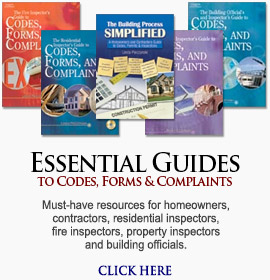Alternate materials and means of construction
The blog has been silent for awhile because I was on a wonderful vacation in Japan (more on that later). But, while I was away, I had an interesting comment from Mark Gilligan regarding alternative materials. He’s given me permission to post his remarks because he’d really like to bring this issue up for discussion. Here it is:
I would appreciate comment on what I see as problems associated with the use of products that are not addressed in the building code that are used in building projects. Many of these products are ubiquitous in that they are regularly used on projects. In many cases product evaluation reports are accepted as de facto code provisions by both design professionals and building officials. While this issue is most blatant in California my understanding is that the troublesome practices also occur in the rest of the country.
These products are considered as alternate materials and means of construction and are addressed by Section 104.11 of the 2009 IBC which requires that the building official approve their use. I believe that there are a number of legal difficulties related to common practices that could result in much mischief. Some of the problems include:
· In, I would suggest, almost all cases when the building official is aware of the products and accepts their use on projects the building official does not formally indicate his approval of the use as required by the building official. Without this formal approval the use of the product would be considered a deviance from the building code. Thus if at any time there is a problem associated with the use of these alternate materials or means of construction the design would be considered to be in violation of the code.
· Many building officials have adopted a policy that they will automatically accept ICC-ES evaluation reports as evidence of code compliance for alternate methods of construction. Besides abrogating their non-delegable duty to approve the use of the products to a private entity, this policy effectively amends the building code. While “Legal Aspects of Code Administration” page 20 talks about a minimal distinction between granting approval of an alternate product and amending the code, I believe that such practices totally ignore any such distinction.
· The insistence by many building officials that they will only accept ICC-ES evaluation reports as evidence of code compliance creates a situation where the building official is in effect creating an unfair advantage in favor of evaluation reports produced by ICC-ES.
Because these practices are so widespread sorting these problems out will be messy. The problems are made more difficult because the use of alternate products is so widespread. Complying with the regulations would make more work for the building officials. Many product manufacturers have a lot invested in the de facto code status of evaluation reports. In addition the inability to rely on evaluation reports as proof of code compliance could create difficulties for the Owner and his consultants.
I believe that long term solution is to develop consensus standards for these products that focus on performance characteristics and not proprietary details. These standards would then be adopted into the IBC thus removing the need for the building official to approve the use of the products.
I would suggest that this is a classic situation where the standard practices that have been adopted by a segment of society are in conflict with the laws and regulations.


Ordinance language helps. The statement: “Repairs must be made in a workmanlike manner in compliance with all applicable local and state building codes and ordinances” usually covers it.
When in doubt, it never hurts to require review by an engineer who provides a signed, stamped approval of the method of repair or construction. That releases the enforcment entity of liabilities in approving a repair that is not addressed clearly in ICC or IPMC.
John
I am having trouble relating your comment to the issue of alternate materials and means of construction when these alternates are a part of the original permit submittal package and where there are no applicable provisions in the building codes and ordinances. The use of these alternates are proposed by the engineer of record and he has stamped and signed the submitted plans and specifications.
The stamping and signing of the submittal is required by the state licensing laws and by the building code and not for the purpose of relieving the building department of liability.
Would suggest that if the building department acts in accordance with Section 104.11 that the building department has little to no liability but if the building official does not indicate his approval of the specific alternates the Owner and the engineer can have significant liability exposure.
Would also suggest that the engineer’s stamping and signing the submittal doesn’t relieve the building department of their responsibility to review and approve nor of any liability that they might have.
I am coming at it from the perspective of a Code Enforcement Officer and not a Building Inspector. An example that I saw yesterday was the OSB siding for a garage that someone tried to pass off as acceptable. Another example was the Skoal can junction box for an electrical splice in a wall.
Do you have a picture of that Skoal can junction box I can post? That sounds like a classic.